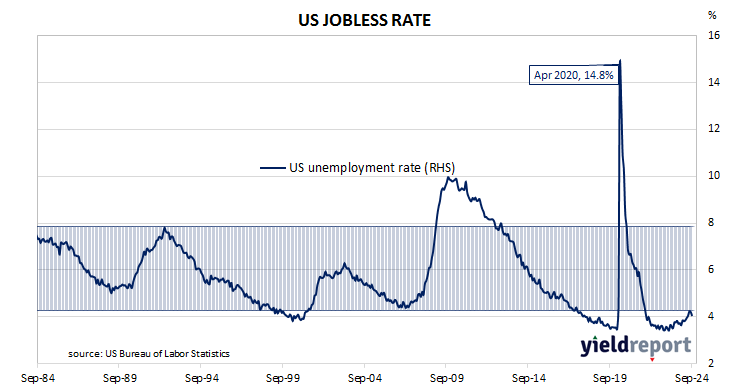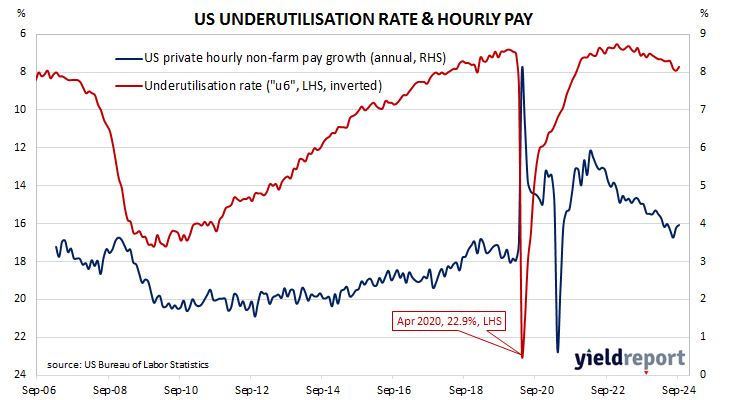Summary: US non-farm payrolls up 254,000 in September, above expectations; previous two months’ figures revised up by 72,000; jobless rate ticks down to 4.1%, participation rate steady at 62.7%; ANZ: gains are broad-based; US Treasury yields rise significantly; expectations of Fed rate cuts softens, five cuts still priced in; employed-to-population ratio steady at 60.0%; underutilisation rate declines to 7.7%; annual hourly pay growth accelerates to 4.0%.
The US economy ceased producing jobs in net terms as infection controls began to be implemented in March 2020. The unemployment rate had been around 3.5% but that changed as job losses began to surge through March and April of 2020. The May 2020 non-farm employment report represented a turning point and subsequent months provided substantial employment gains which have continued to the present.
According to the US Bureau of Labor Statistics, the US economy created an additional 254,000 jobs in the non-farm sector in September. The increase was greater than the 140,000 rise which had been generally expected as well as the 159,000 jobs which had been added in August after revisions. Employment figures for August and July were revised up by a total of 72,000.
The total number of unemployed decreased by 281,000 to 6.834 million while the total number of people who were either employed or looking for work increased by 149,000 to 168.698 million. These changes led to the US unemployment rate ticking down from 4.2% in August to 4.1%. The participation rate remained steady at 62.7%.
“The job gains were broad-based; private sector payrolls rose 223,000 and government payrolls were up 31,000,” said ANZ economist Sophia Angala.
US Treasury bond yields rose significantly across a much-flattened curve on the day. By the close of business, the 2-year yield had jumped 21bps to 3.92%, the 10-year yield had gained 11bps to 3.96% while the 30-year yield finished 7bps higher at 4.25%.
In terms of US Fed policy, expectations of a lower federal funds rate in the next 12 months softened, although at least another five 25bp cuts are still factored in. At the close of business, contracts implied the effective federal funds rate would average 4.63% in November, 20bps less the current rate, 4.445% in December and 4.075% in February. September 2025 contracts implied 3.465%, 136bps less than the current rate.
One figure which is indicative of the “spare capacity” of the US employment market is the employment-to-population ratio. This ratio is simply the number of people in work divided by the total US population. It hit a cyclical-low of 58.2 in October 2010 before slowly recovering to just above 61% in early 2020. September’s reading remained unchanged at 60.0%, some way from the April 2000 peak reading of 64.7%.
Apart from the unemployment rate, another measure of tightness in the labour market is the underutilisation rate. The underutilisation rate registered 7.7% in September, down from August’s figure of 7.7%. Wage inflation and the underutilisation rate usually have an inverse relationship and private hourly pay growth in the year to September accelerated from 3.9% to 4.0%.



